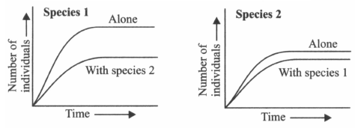Two species competing for the same resource can avoid competition by choosing different habits. This phenomenon is called_________and was supported by _____

Important Questions on Organisms and Populations
In laboratory experiments, two species of the protist Paramecium (species 1 and 2) were grown alone and in the presence of the other species. The following graphs show growth of species 1 and species 2, both alone and when in mixed culture with the other species.

Which of the following conclusions can be drawn from the graphs?
Read the following statements and select the correct option.
Statement 1: Brood parasitism in birds is an example of parasitism in which the parasitic bird lays its eggs in the nest of its host and the host incubates them.
Statement 2: During the course of evolution, the eggs of the parasite bird have evolved to resemble the host's eggs in size and colour to reduce the chances of the host bird detecting the foreign eggs and removing them from the nest.
(i) The liver fluke, a parasite, depends on intermediate hosts (a snail) to complete its life cycle.
(ii) The malarial parasite needs a vector (mosquito) to spread to other host organisms.
(iii) In case of brood parasitism, the eggs of parasitic birds are not detected and removed from the nest because the parasite's eggs resemble the host's eggs in morphology and colour.
(iv) A population of frogs protected from all predators would increase indefinitely.
(i) An orchid growing as an epiphyte on a mango branch.
(ii) Barnacles growing on the back of a whale.
(iii) Clown fish living among the stinging tentacles of sea anemone.
(iv) Cattle egrets foraging close to the grazing cattle. Which kind of interaction is being cited by these?
